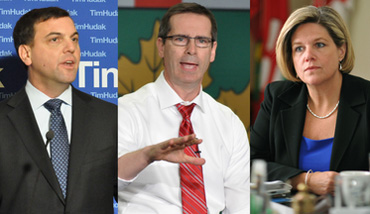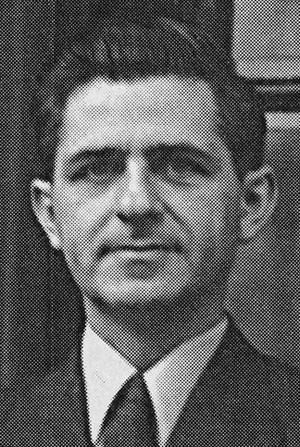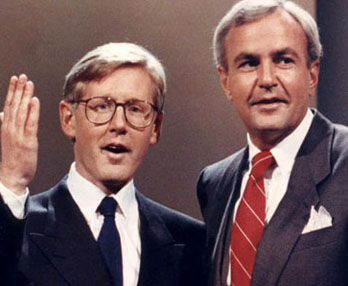Maybe there’ll be a dreaded “coalition” in Ontario after October 6 vote?
Aug 25th, 2011 | By Randall White | Category: In Brief
Ontario party leaders 2011, l to r: Tim Hudak (Conservative), Premier Dalton McGuinty (Liberals), and Andrea Horwath (NDP).
The serious part of the 2011 Ontario provincial election campaign is now less than two weeks away. And the excitement is building ( for some of us at least). This past weekend Chantal Hébert was explaining just why “Ontario vote most important in recent history.” And yesterday Duff Conacher’s Democracy Watch in Ottawa was complaining that “Elections Ontario continues to fail to inform voters of their full voting rights” in the important election that will finally take place on Thursday, October 6 – just before the Canadian Thanksgiving weekend.
For a while earlier on the comparatively few opinion polls that get done on Ontario provincial politics seemed to be suggesting that the October 6 election would be Conservative leader Tim Hudak’s to lose. The electorate’s welcome for the two-term McGuinty Liberal government was wearing thin, in various kinds of difficult times. And it seemed possible that the success of the federal New Democrats, and massacre of federal Liberals, in the May 2, 2011 Canada-wide election, just might spill over into the regional politics of Canada’s most populous province. (And even now “Ontario’s NDP leader is counting on the spirit of her late federal counterpart Jack Layton to lift the party in the provincial election.”)

David Lewis at the 1944 Commonwealth Labour Parties conference in the United Kingdom. In 1972—1974, as leader of the New Democratic Party in Canada, he kept the Trudeau Liberals in office. Library and Archives Canada C-007253.
The two most recent Ontario polls, by Ipsos Reid and Nanos Research, suggest something a little different. The Ipsos “flash sample” poll conducted over the weekend of August 6—7 showed Conservatives 38%, Liberals 36%, NDP 23%, and Green Party 3%. In similarly rounded numbers the Nanos poll, conducted August 10—13 showed Conservatives 42%, Liberals 38%, NDP 16%, and Green Party 4%. A projection of seats in the Legislative Assembly at Queen’s Park based on these two polls, by Barry Kay, associate professor of political science at Wilfrid Laurier University, appeared yesterday. And it assigns 51 seats to the Hudak Conservatives, 41 seats to the McGuinty Liberals, and 15 seats to Andrea Horwath’s New Democrats.
Pondering these recent numbers suggests that some kind of (in some quarters controversial) “coalition” government, which was much talked about but never finally came to pass in the May 2 federal election, just might materialize in Ontario instead on October 6. On the evidence of both the Ipsos and Nanos polls, a substantial enough majority of voters would prefer one or the other of the “left” Liberal or New Democrat parties, over the “right” Conservative party (54% according to Nanos and 59% according to Ipsos). And Barry Kay’s seat projections also give the Liberals and New Democrats together a slender majority of 56 seats in the Legislative Assembly. The best the Conservatives could do with their 51 seats (54 is a bare majority in the current 107-seat legislature) is a minority government.

Bob Rae (l) and David Peterson prepare for an election debate in August 1990. Not too long before, their 1985 Liberal-NDP Accord ended 42 years of – albeit rather “Red” – Tory domination in Ontario provincial politics, even though Frank Miller’s Progressive Conservatives still had the single largest number of seats in the legislature at Queen’s Park. Hans Deryk / The Canadian Press.
In a somewhat similar circumstance in 1985 the Ontario Liberals and New Democrats actually did co-operate with an “Accord” that let the David Peterson Liberals govern for two years. This was not quite a “coalition,” as the term is customarily understood (where both parties have ministers in the cabinet, eg). But some would say it is (or was) close enough for jazz. A even less formal arrangement between federal Liberals and New Democrats also let Pierre Trudeau’s second Liberal government remain in office between 1972 and 1974 in Ottawa.
There are those who still believe that the only serious way ahead for the progressive “left” in Canadian federal politics lies in some new form of Liberal-New Democrat co-operation. According to Chantal Hébert in the Toronto Star last Saturday: “the New Democrats and the Liberals will not pose a serious threat to the ruling Conservatives until they figure out a way to aim together in the same direction rather than shoot each other in the foot.” According to Warren Kinsella in the Toronto Sun this past Monday, with the sad death of their leader, there “is no possibility, none, that” the federal New Democrats “can ever expect to maintain what they achieved with Jack Layton.” And now, more than ever, “progressives need to come together for the good of Canadian democracy.” Yet another intriguing possibility about the October 6 Ontario election is that it just might create the practical circumstances for a provincial experiment with this Canadian democratic need at Queen’s Park.


You have really interesting blog, keep up posting such informative posts!
[Cweditors: We’ve let this comment spam ad go through, because the Thai blog does have some excellent photos of Thailand, and its undeniably awesome heritage buildings! Click on “Grand Palace” above.]